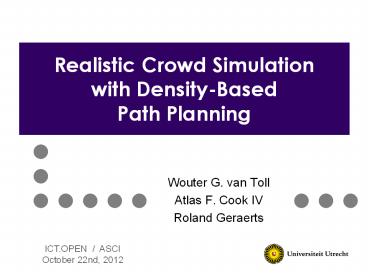Wouter G. van Toll - PowerPoint PPT Presentation
Title:
Wouter G. van Toll
Description:
Title: MSc Thesis Presentation Subject: A navigation mesh for efficient density-based crowd simulation in multi-layered environments Author: Wouter van Toll – PowerPoint PPT presentation
Number of Views:47
Avg rating:3.0/5.0
Title: Wouter G. van Toll
1
Realistic Crowd Simulationwith Density-Based
Path Planning
- Wouter G. van Toll
- Atlas F. Cook IV
- Roland Geraerts
ICT.OPEN / ASCI October 22nd, 2012
2
Introduction
- Path planning in virtual environments (e.g.
games) - Global planning find a main route
- Local planning variety, collision avoidance
- Many characters at once crowd simulation
- Problem in a crowd, short routes are not always
good - Collision avoidance cannot solve everything
- Other routes are unused
3
Overview
- We use crowd density information for global
planning - Stored in a navigation mesh (Explicit Corridor
Map) - Planning algorithm time-based A
- Periodic replanning
- Results
- Characters take detours around congested areas
- Crowd spreads over different routes
- Efficient tens of thousands of characters in
real-time
4
Sneak preview
- Before After
5
Preliminaries
- Navigation Meshes / Crowd Density
6
Navigation meshes
- Characters need to find paths through an
environment - Navigation graph 1D edges
- Not flexible enough for crowds
- Navigation mesh 2D polygons
- Global path sequence of polygons
- Local planning during movement
- Common in modern games / simulations
- Crowd simulation has been solved!
- Assumptions in the navigation mesh / crowd
- General framework?
7
Explicit Corridor Map
- An exact and flexible navigation mesh
- Medial axis
- Closest-obstacle annotations
- A on the medial axis ? path
- corridor
- Shortest paths with clearance
- Collision avoidance
- Multi-layered environments
- Dynamic updates
8
Crowd density
- Fraction of a region Ri that is occupied by
characters - Often in persons per m²
- Often in levels and colors
- For us value ?i between 0 and 1
- (allows multiple character sizes)
- Practical studies
- When the density is high,people walk more slowly
- Density-speed function v(?) 0,1 ? 0, vmax
- Time-based path planning?
F
E
D
C
B
A
9
Method
- Density Map / Density-Based Path Planning
10
Density map
- ECM divides the environment into non-overlapping
regions - Each region maps to an ECM edge
- Each region stores its local density
- Updated in real-time
- Density of a region
- ? Expected walking speed within the region
- ? Expected traversal time of the edge
- ? Expected delay
11
Density-based path planning
- A search on the medial axis
- A character wants a fast path, not necessarily
the shortest - Each ECM edge ei has a density ?i
- tmin(ei) traversal time at speed v(0) vmax
- tdens(ei) traversal time at speed v(?i)
- tdelay(ei) tmin(ei) - tdens(ei)
- cost(ei) tmin(ei) w tdelay(ei)
- Controlling the sensitivity to delays
- w 0 shortest path
- w 1 fastest path (Höcker et al., 2010)
- w gt 1 more eager to take detours
12
Replanning
- Densities change all the time
- Characters should re-check their paths
- We cannot see crowds that are far away
- Density viewing distance D along the medial axis
- A if the path length gt D, assume ? 0
- ? Path has a visible and an invisible part
- Partial replanning re-use invisible parts
- Character has moved
- More points are visible
- At a mutually invisible point, A can stop
- ? Speed vs. knowledge
13
Results
- Realistic Crowds in Real-Time
14
Experimental results
- Varying the cost weight w
- w 0 ? congestions
- w 1, no replanning ? periodic effect
- w 1, replanning ? realistic crowd flow
- ? longer but faster paths
- w gt 1 ? larger detours, indecisive crowd
- ? Useful in other environments?
- Varying the viewing distance
- 1 - 2 ms in a large city
- Real-time periodic replanning
- Multi-threading steering 50K characters in 30
ms/frame - 70 ms/frame left for e.g. replanning
D 8
D 350 m
D 0 m
15
Closing Comments
- Conclusions / Future work
16
Conclusions
- The ECM navigation mesh serves as a density map
- Non-overlapping, exact, always defined
- Region densities map to edge speeds
- Updated in real-time
- Characters use density-based A
- Short paths with little expected delay
- Sensitivity to delay can be set
- (Partial) replanning
- Result More realistic crowds
- Characters spread over routes
- Characters avoid congestions
- Emergent global effects due to individual
choices - (Still) real-time performance for large crowds
17
Future work
- New questions
- Use flow information? (speed direction)
- Use actual visibility?
- Event-based vs. periodic replanning
- Plan with terrain information?
18
More information
- Poster
- Contact us
- W.G.vanToll_at_uu.nl
- R.J.Geraerts_at_uu.nl
- http//people.cs.uu.nl/roland/
- Questions?































